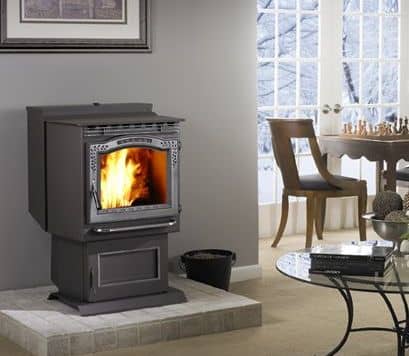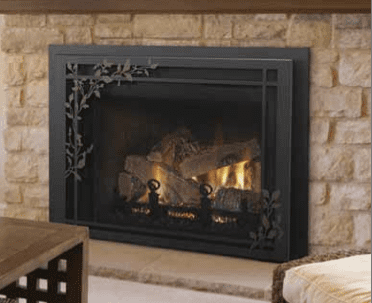How to Install a Pellet Stove Through Chimney
J. Ezra Gordon is a Boston-based marketer and writer interested in a wide variety of topics.

This article discusses various information on wood stoves, pellet stoves and fireplace inserts.
Harman Stoves
Heating Your Home With Wood or Pellets
The first thing you should ask yourself before considering a wood or pellet stove is: why am I doing this? To save money? To go green? To have a heating source off the grid? All of these things are possible, but how you answer will determine what fuel source and stove type are right for you.
Wood and pellet stoves have come a long way in a relatively short amount of time. You may have an image in your head of the cast iron wood stoves used during the energy crisis of the 1970s - dirty, inefficient, and often times ugly and oversized. Plus, wood stoves often relied solely on unregulated radiant heat to warm a home, meaning the room containing your stove would turn into a sauna while the rest of your house felt like an ice palace. But those days are long gone.
Modern-day wood and pellet stoves are much more efficient and burn much hotter and cleaner. They come as freestanding units that can be set upon a heat-resistant hearth or conveniently inserted into an existing fireplace. They can burn less fuel for longer, reducing both the cost of fuel and the number of times the unit needs to be refueled in a day. In short, wood and pellet stoves are more than just an alternative to oil or gas, they are actually cost-saving, eco-friendly units that are easy to use—a modern-day convenience, and just as justifiable (if not more) as any other appliance.

A Harman Stove, the P68 Pellet Stove can easily heat a 2,000+ sq.-ft. home with up to 68,000 BTUs of heat.
Will I Save Money With a Wood or Pellet Stove?
The first question everyone asks—often before they even know how these stoves work—is how much money will they save, and how long will it be before they see a return on my investment?
The answer is—it depends. How well insulated is your home? Does the layout allow warm air to flow easily from room to room? Are you planning on supplementing your oil or gas heat, or replacing it? Are your near a pellet or wood distributor that can offer you a good price on fuel? There are just too many questions before anyone can reasonably answer the money question. Find yourself a reputable stove dealer in your area, and have them come out to your house for an appraisal.
In the meantime, this may help:
- Wood and pellet heat are, on average, considered to be 6x cheaper than oil or gas.
- The US Government offers a green tax credit of up to 30% of the cost of your stove if it has a 75+% efficiency rating.
- Wood or pellet stoves and inserts tend to be attractive to homebuyers, so while a stove may not increase the official appraisal of your home (although, it can in some instances), it can certainly tip the scales or help heat up any bidding.

What Pellet Fuel Looks Like

How Pellet Stoves Work
What Are Pellet Stoves?
If you're looking for a regulated, thermostat-controlled, relatively green, and easy-to-use alternative form of heating, then pellet stoves are an excellent option. And if you have any preconceived notions about their appearance or functionality, you should know these units have come a long way in the past decade or so.
A pellet stove works by automatically feeding biomass fuels (pellets filled with combustible, organic materials) into a self-igniting firebox, fueling that flame with a fan, and then blowing that heat through an external vent. While the bodies of the pellet stoves do get hot, they don't get nearly as hot as wood stoves, and therefore don't rely on radiant heat to warm your home.
Benefits of a pellet stove:
- Easy to use: simply drop a bag of pellets into the hopper, turn it on, and walk away for 4-12 hours, depending on the size of the hopper (the box on the back that holds the pellets) and how much heat you're trying to create.
- Automatic heat regulation: a thermostat goes a long way, especially if you're just trying to heat a couple of rooms or a small house. Set it to 70 degrees and let the unit do the rest of the work.
- Clean burn: assuming you're using dry pellets made with quality ingredients, you're pellet stove should burn hot enough to stay relatively clean, and the output is considered to be carbon neutral. Finding quality pellets can be a chore, depending on your location. Don't rely on Lowes or Home Depot—find yourself a pellet stove dealer and ask them to ID a distributor of quality pellets in your area.
Disadvantages of a pellet stove:
- Electricity: Because they use a thermostat, an automatic feed, and a couple of fans, your pellet stove is going to need to use electricity. That isn't to say you aren't going to need electricity for your wood stove (depending on the model), but if you're looking for an "off the grid" heating alternative, pellet stoves are not an option.
- More likely to break: There are a lot of working parts in a pellet stove, and every working part increases the probability of malfunction. Even if you're using a reputable, top-of-the-line brand, you're more likely to have to replace parts in a pellet stove than a wood stove.
- Finding pellets: This can be a major hassle. It's likely you can find wood to burn in your area—either through a vendor or by cutting and drying your own. Pellets have to be purchased, and they have to be of a certain quality or they'll coat all those breakable parts with creosote. Make sure you can purchase pellets in your area, or even have them delivered, before you consider buying a pellet stove.
If you're looking for a greener alternative, consider how much energy it takes to create, package, and ship pellets, and how easy it can be to find and sell wood. Even if pellet stoves were greener than wood stoves (which some claim to be), you still have to consider the energy and cost of getting that fuel to you.
However, if, say, you have a young family, and you're looking for a more convenient alternative that isn't as dangerous to the touch as wood stoves, then pellet stoves might be right for you.

Is Burning Wood or Pellets Bad for the Environment?
No. Or yes. Depending on who you ask. Newer models of both wood and pellet stoves are considered to be clean-burning - in other words, they burn so hot that more than 92% of the fuel is consumed, reducing the density of particulates that are vented to almost negligible levels. However, if you have an older stove, chances are it doesn't use this clean-burning technology, and probably shoots big, billowing clouds of black smoke from your chimney. As you can imagine, this is NOT good for the environment.
Read More From Dengarden
The newer technology is considered to be so clean that some countries, such as Norway, actually have government programs in place to replace old stoves with newer, cleaner models. And, as previously mentioned, Homeowners in the US can get a green tax credit of up to 30% of the price of their wood or pellet stove, assuming it has a 75% efficiency rating or higher.

Gas Fireplaces: Pretty, but not hot
Are Wood and Pellet Stoves Better Than Gas?
Gas stoves and fireplaces are incredibly convenient, and sometimes the minimal amount of warmth they can offer is all you really need to supplement your standard heating system. But keep in mind two things:
- Gas stoves or fireplace inserts are not going to provide you with a significant amount of heat - at least compared to the heat provided by a wood or pellet stove.
- You're still burning fossil fuels. There's nothing green or cost saving about using a gas fireplace.
Gas fireplaces are generally used for decoration or convenience. In that sense, yes, they are better than wood or pellet stoves, but they aren't an efficient, sustainable, or remotely eco-friendly heating source.
What Else Should I Know?
For one, wood and pellet stoves are kind of fun. There's a satisfaction to creating your own heat, and there's something emotionally warming about having a fire going in your home.
BUT - stoves do require maintenance. Either you need to keep your stove clean and well-maintained, or you need to make sure the business that sold you your stove comes out for regular maintenance (about once a year).
Fireplace inserts are more convenient than freestanding stoves in many ways, but primarily because you already have a flue you can run pipe through - no real construction needed. Freestanding stoves are going to have be vented through your roof, or with some pellet stoves, horizontally through a wall.
Finally, don't purchase a stove through a hardware store or online - buy it from a local shop. Find someone who can service your stove, get you parts when you need it, or at least help you trouble-shoot problems. You're making an investment, and that investment is worth more when it comes with a team on your side.
Now - choosing the right stove for your home is another article completely, with a look at the kinds of stoves on the market, BTU to square feet conversions, and more. I'll link to it here when that's completed. In the meantime, start looking online, and see if you can find a local stove shop in your area.
Review of the Top 5 Best Pellet Stoves in 2021
This article is accurate and true to the best of the author's knowledge. Content is for informational or entertainment purposes only and does not substitute for personal counsel or professional advice in business, financial, legal, or technical matters.
Joseph DuranJr of NM on April 03, 2019:
My dad has a Regency wood insert to his old fireplace. Cost $3,200 plus installation, cost of wood, chopping wood, stacking wood and cleaning a lot of ash on a daily basis. Heat for a 2,000 sq ft home. Decent.
I purchased a pellet stove to heat my 2,000 sq ft home. It burns all day and I'm left with 1/4 cup of ash and it keeps the entire home at a constant 70-74 degrees in winter. Easy seasonal clean up and cost me $1,200 installation included. Bags of pine $5.18 don't burn as hot as oak (oak is $5.98-$6.29 seasonal demand).
My pellet stove is made by New Englander and I've only replaced a 1mph clockwise motor in 18 years. Cost $45.00. Simple do it yourself installation.
Electric bill not much higher.
Sharon Whittington from Labarque Creek, MO 63069 on November 13, 2017:
Hmm... Something to think about. Thanks.
Chris on January 19, 2015:
I want to buy an insert pellet fire for my home in Southern Spain, an
Antique looking but can't find a dealer.
How to Install a Pellet Stove Through Chimney
Source: https://dengarden.com/home-improvement/Wood-Stoves-Pellet-Stoves-Are-They-Worth-It